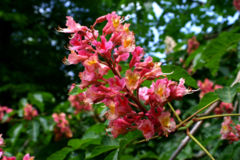Red Horsechestnut
| Aesculus x carnea subsp. var. | Red horse chestnut | |||||||||||||||||||||||||||||||||||||||||||||||||||||||
|---|---|---|---|---|---|---|---|---|---|---|---|---|---|---|---|---|---|---|---|---|---|---|---|---|---|---|---|---|---|---|---|---|---|---|---|---|---|---|---|---|---|---|---|---|---|---|---|---|---|---|---|---|---|---|---|---|

|
|
| ||||||||||||||||||||||||||||||||||||||||||||||||||||||
| ||||||||||||||||||||||||||||||||||||||||||||||||||||||||
Aesculus × carnea is a hybrid between the Red Buckeye (A. pavia) and the Common Horse-chestnut (A. hippocastanum). The origin of the tree is not known, but it is probably a chance garden hybrid, appearing in Germany before 1820. The hybrid is a medium-size tree to 20-25 m tall, intermediate between the parent species in most respects, but inheriting the red flower color from A. pavia. It is a popular tree in large gardens and parks, most commonly the selected cultivar 'Briotii' (named in 1858 to honor Pierre Louis Briot, the nurseryman at Trianon-Versailles near Paris, France), which has 10-inch tall, deep rosy flowers and matures as a smaller tree. Other cultivars are 'O'Neil',which produce larger (10-12 inch), brighter red flowers, 'Fort McNair' (named from where it was selected), which has dark pink flowers with yellow throats and resists leaf scorch and leaf blotch, and 'Plantierensis', which has intense rose pink flowers with yellow throats and does not set fruit, which makes it less messy.[1]
| Standard Cyclopedia of Horticulture |
|---|
|
Aesculus carnea, Hayne (AE. Hippocastanum X Pavia. A. rubicunda, Loisel., AE. intermedia, Andre). Tree, 20-40 ft.: lfts. mostly 5, nearly sessile, cuneate-obovate, crenate-serrate, nearly glabrous: panicles 5-8 in. long; fls. varying from flesh-color to scarlet: fr. with small prickles. Garden origin.—Common in parks and on roadsides. Handsome and desirable; the foliage is darker and of firmer texture than that of the preceding species and resists drought better. Many garden forms, according to the different shades in coloring; one of the best is var. Briotii, Nichols. (AE. rubicunda var. Briotii, Carr.), with bright scarlet fls. Also var. plantierensis, Rehd. (AE. plantiereinsis. Andre), with yellowish white fls. tinged with pink and fading to pink and with bluntly serrate lfts., is very handsome.
|
Cultivation
Propagation
Pests and diseases
Varieties
Gallery
-
photo 1
-
photo 2
-
photo 3
References
- ↑ Roth, Susan A. (2001). Taylor's guide to trees. Boston, MA: Houghton Mifflin Harcourt. pp. 408. ISBN 9780618068890. http://www.amazon.com/gp/product/0618068899.
External links
- w:Red Horsechestnut. Some of the material on this page may be from Wikipedia, under the Creative Commons license.
- Red Horsechestnut QR Code (Size 50, 100, 200, 500)
